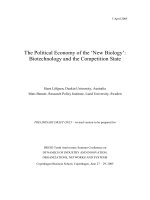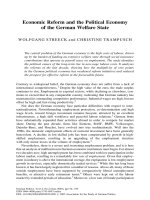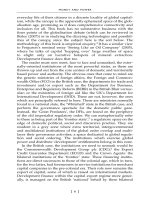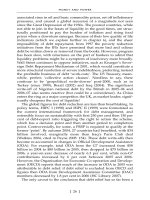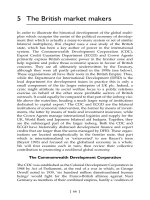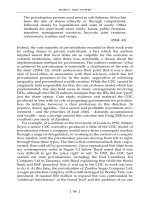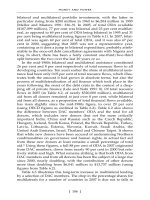Civic crowdfunding participatory communities, entrepreneurs and the political economy of place
Bạn đang xem bản rút gọn của tài liệu. Xem và tải ngay bản đầy đủ của tài liệu tại đây (9.82 MB, 173 trang )
Civic Crowdfunding: Participatory Communities,
Entrepreneurs and the Political Economy of Place
by
Rodrigo Davies
B.A., Oxford University (2003)
Submitted to the Department of Comparative Media Studies
in partial fulfillment of the requirements for the degree of
Master of Science in Comparative Media Studies
at the
MAY 2 7 01
MASSACHUSETTS INSTITUTE OF TECHNOLOGY
June 2014
@Rodrigo Davies, 2014. All rights reserved. The author hereby
grants to MIT permission to reproduce and to distribute publicly
paper and electronic copies of this thesis document in whole or in part
in any medium now known or hereafter created.
Signature redacted
........................
Department of Comparative Media Studies
May 9, 2014
A uthor .
Signature redacted
Certified by.
Ethan Zuckerman
Director, Center for Civic Media
Thesis Supervisor
Sign ature redacted
Accepted by.. -
. .. ... . . .-.
OF TECHNOLOGY
.. . . . . . . . . . . .. . . . .
Heather Hendershot
Director of Graduate Studies, Comparative Media Studies
Civic Crowdfunding: Participatory Communities,
Entrepreneurs and the Political Economy of Place
by
Rodrigo Davies
Submitted to the Department of Comparative Media Studies
on May 9, 2014, in partial fulfillment of the
requirements for the degree of
Master of Science in Comparative Media Studies
Abstract
Crowdfunding, the raising of capital from a large and diverse pool of donors via online platforms, has grown exponentially in the past five years, spurred by the rise of
Kickstarter and IndieGoGo. While legislative attention in the US has turned to the
potential to use crowdfunding as a means of raising capital for companies, less attention has been paid to the use of crowdfunding for civic projects - projects involving
either directly or indirectly, the use of government funds, assets or sponsorship, which
may include the development of public assets. This project analyzes the subgenre of
civic crowdfunding from three perspectives. First, it provides a comprehensive quantitative overview of the subgenre of civic crowdfunding, its most common project
types and its geographic distribution. Second, it describes three edge cases, projects
that, while uncommon, demonstrate the current limits, aspirations and potential future path of the subgenre. Third, it analyzes the historical and intellectual paradigms
within which civic crowdfunding projects and platforms are operating: whether they
are best located within the historical context of community fundraising, participatory planning, entrepreneurial culture or a combination of the three. In addressing
these questions, the thesis will explore the potential benefits and challenges of using
crowdfunding as a means of executing community-oriented projects in the built environment, and offer proposals for how public and non-profit institutions can engage
with crowdfunding to realize civic outcomes.
Thesis Supervisor: Ethan Zuckerman
Title: Director, Center for Civic Media
Thesis Supervisor: Jim Paradis
Title: Professor, Comparative Media Studies
3
4
Acknowledgments
Great thanks are due to Ethan Zuckerman and Jim Paradis, who have inspired, tested,
challenged and significantly improved the research throughout.
I would also like to thank Xavier De Souza Briggs for encouragement and guidance
at a critical moment in the process, and Kate Crawford for inspiring me to see this
work as the first step in a longer research journey. I'm delighted to be continuing
that journey from here on. Thank you to Sinan Aral for some sage advice in that
regard and to Melissa Valentine for creating such an exciting opportunity.
Thank you to Jase Wilson, Sarah Shipley, Chris Gourlay, Louisa Addiscott, Tomas De
Lara, Erin Barnes, Brandon Whitney, Niraj Dattani, Rodrigo Maia, Luciana Masini,
Sean Connolly, Jordan Raynor, Alison Hynd and the MIT Public Service Center for
giving me the opportunity to learn about so much of the wonderful work being done
in the field.
Several other folks provided enthusiasm and interest in my project when I needed it
most, particularly Lucy Bernholz, Susan Crawford, Archon Fung, Jess Goldfin, Rob
Goodspeed, Aditi Mehta and Erik Duhaime.
Thank you to to William Uricchio, Sasha Costanza-Chock, Heather Hendershot, Ed
Schiappa and the rest of Comparative Media Studies for giving me such a wonderful
platform to explore and research. Shannon Larkin, your unparalleled ability to make
things better will be missed.
This project would not have been possible without the irrepressible creative force of
Eduardo Marisca. I could not have wished for a better co-conspirator and friend over
the past two years.
I am extremely grateful to Helena Puig Larrauri, Chris Peterson, Gavin Lawson and
Conor O'Neill for their support and input.
And finally, thank you to Erica, for your creativity, meticulousness, and most of all,
your tireless positive energy and calmness when both mine were absent.
5
6
Preface
I was living in Mumbai when I first heard about Spacehive, a UK-based crowdfunding platform that was helping a community group to finish the building of a $1.2M
community center in Pontypridd, South Wales, in 2012. It was a surprising story to
me, for several reasons: I knew that Pontypridd was one of the poorest communities
in the country, with close to seventy-five percent unemployment. Having grown up
20 miles away in a Newport public housing project, I had first-hand experience of the
three decades-old erosion of social capital in tandem with the decline of coal and steel
industries around which most of the region's communities had been formed. Institutional decline was commonly seen as a consequence of exogenous economic forces,
over which individuals felt they had little influence. The discovery that this region
was now engaged in large-scale organized community problem-solving a gap in funding -
in this case
intrigued me.
I found the story intriguing enough that I decided to spend four months advising Spacehive after returning to London from India. I was asked to help community
groups develop campaign materials and strategies, drawing on my seven years as
a journalist at the BBC, Conde Nast and Bloomberg. It quickly became apparent
to me, though, that the significance of the emergence of quasi-public crowdfunding
projects extended far beyond fundraising. What crowdfunding offered was not simply
a sophisticated way for communities to demand something, but a moment of organizational restructuring in which new forms and infrastructures were emerging that
could open fresh pathways for communities to participate in shaping their environment. Spacehive was also in a position to create new operational structures. With
this in mind, the company's founder Chris Gourlay and I developed a model to al7
low Spacehive to partner with non-profits and municipal governments. One of the
outcomes was the creation of the world's first crowdfunding initiative led by a municipality, Bristol, an early example of a crowd-supported public-private partnership.
Beyond the legal and policy questions the company faced, these experiments led me
to reflect critically on the broader questions they raised. I was interested in the longterm sustainability of projects, the accountability and risk management of funding
processes and the redrawing of the boundaries of work and civic responsibility these
initiatives appeared to signal.
This thesis is the product of the two years since that I have spent exploring
civic crowdfunding and some of its organizational and societal implications. These
years have been a combination of research and practice: while studying the practice
and system of civic crowdfunding, I have held workshops on crowdfunding, spoken
on the topic at venues such as the Library of Congress and the technology industry
festival South By Southwest Interactive, and advised senior officials in U.S. municipalities on crowdfunding. While I am enthusiastic about opportunities to engage with
practitioners, my interest in the topic is rooted not simply in its current novelty or
political currency, but rather its relationship to the social and organizational issues
that underpin its development.
The goal of this project is to provide an overview of civic crowdfunding, to
begin to explore these deeper issues, and to invite other researchers and practitioners
to join me in that effort.
8
Contents
Preface
7
Introduction
17
1
Civic crowdfunding and its histories
25
1.1
Delim iting Civic Projects . . . . . . . . . . . . . . . . . . . . . . . . .
28
1.2
Histories of community fundraising and the Statue of Liberty . . . . .
31
1.3
The conditions for crowdfunding . . . . . . . . . . . . . . . . . . . . .
36
1.4
The practices and dynamics of donation crowdfunding . . . . . . . . .
39
1.5
Crowdfunding as an infrastructure . . . . . . . . . . . . . . . . . . . .
42
2
The field of civic crowdfunding
45
2.1
Overview of platforms in the dataset
. . . . . . . . . . . . . . . . . .
46
2.2
The scale of projects and platforms . . . . . . . . . . . . . . . . . . .
49
2.2.1
C P projects . . . . . . . . . . . . . . . . . . . . . . . . . . . .
49
2.2.2
G P projects . . . . . . . . . . . . . . . . . . . . . . . . . . . .
50
2.3
Growth of projects on civic and generic platforms . . . . . . . . . . .
51
2.4
The problem with success rates and Kickstarter's hidden civic success
54
2.5
The distribution of wealth and activity in civic crowdfunding . . . . .
56
2.6
Types of projects and the goods they produce . . . . . . . . . . . . .
58
2.7
R eplicability . . . . . . . . . . . . . . . . . . . . . . . . . . . . . . . .
62
2.8
Projects by location . . . . . . . . . . . . . . . . . . . . . . . . . . . .
63
2.9
The typical civic crowdfunding project
. . . . . . . . . . . . . . . . .
66
9
3
2.10 Problems with the data. . . . . . . . . . . . . . . . . . . . . . . . . .
68
2.11 C onclusions . . . . . . . . . . . . . . . . . . . . . . . . . . . . . . . .
70
Three Edge Cases of Civic Crowdfunding
73
3.1
Case One: Glyncoch Community Center . . . . . . . . . . . . . . . .
75
3.1.1
A Community Used to Fundraising . . . . . . . . . . . . . . .
75
3.1.2
Celebrity Endorsements, Broadcast Amplification and a LastM inute Flurry . . . . . . . . . . . . . . . . . . . . . . . . . . .
77
An Exercise in Attention, and a Stage-Setter for Spacehive . .
80
Case Two: Sustain Kansas City B-Cycle . . . . . . . . . . . . . . . .
83
3.2.1
A Challenging City for Cyclists . . . . . . . . . . . . . . . . .
83
3.2.2
Hitting the Highs, Struggling with the Lows . . . . . . . . . .
86
3.2.3
A Beacon for Future Campaigns . . . . . . . . . . . . . . . . .
89
3.1.3
3.2
3.3
3.4
Case Three: Pimp My Carroa
. . . . . . . . . . . . . . . . . . . . .
92
3.3.1
Background . . . . . . . . . . . . . . . . . . . . . . . . . . . .
92
3.3.2
Reaching the Target, and Accelerating Beyond
. . . . . . . .
94
3.3.3
Building a Movement and Creating a Successor
. . . . . . . .
96
What the Three Edge Cases Suggest About the Future of Civic Crowdfunding
4
5
. . . . . . . . . . . . . . . . . . . . . . . . . . . . . . . . . .
98
Three competing visions of civic crowdfunding
101
4.1
Civic Crowdfunding as Community Agency . . . . . . . . . . . . . .
103
4.2
Civic Crowdfunding as Individual Agency
. . . . . . . . . . . . . .
112
4.3
The Political Economy of Civic Crowdfunding . . . . . . . . . . . .
119
Conclusions and Further Work
129
5.1
The current state and limitations of civic crowdfunding . . . . . . .
130
5.2
The Institutional Challenges of Civic Crowdfunding . . . . . . . . .
134
5.2.1
Inequality: What the Crowd Wants to Fund . . . . . . . . .
135
5.2.2
Civic Influence: For Whom, From Whom? . . . . . . . . . .
136
10
5.2.3
DIY Institutions, or Weakening Institutions? Four Pathways
for Engagem ent . . . . . . . . . . . . . . . . . . . . . . . . . . 139
5.3
The Road Ahead for Civic Crowdfunding . . . . . . . . . . . . . . . .
Appendix: Data Collection and Dataset Descriptions
11
142
147
12
List of Figures
. . . . . . . . . . . . . . . . . . . . .
1-1
Summary of platform dynamics
2-1
Total Number of Successful Civic Crowdfunding Projects 2011-2013
2-2
Successful Projects Added, Quarter on Quarter
2-3
Distribution of project sizes
2-4
Indicative map of projects by state
40
.
53
. . . . . . . . . . . .
54
. . . . . . . . . . . . . . . . . . . . . . .
57
. . . . . . . . . . . . . . . . . . .
64
2-5
Density of projects by state median income . . . . . . . . . . . . . . .
65
2-6
Density of projects by state population . . . . . . . . . . . . . . . . .
66
3-1
Web search traffic for the term "glyncoch" recorded by Google Trends
79
3-2
Pledges to the Glyncoch campaign by amount
. . . . . . . . . . . . .
81
3-3
Pledges to Sustain Kansas City B-Cycle as a percentage of the target,
in chronological order . . . . . . . . . . . . . . . . . . . . . . . . . . .
87
3-4
Percentage pledged to PMC by number of backers . . . . . . . . . . .
95
5-1
The integrity of crowdfunding projects by funding mix and level of
community ownership . . . . . . . . . . . . . . . . . . . . . . . . . . .
13
134
14
List of Tables
2.1
Overview of Civic Crowdfunding Platforms discussed in Chapter 3
2.2
Overview of Project Sizes (CP and GP) . . . . . . . . . . . . . . . . .
51
2.3
Successful projects posted 2011-2013, quarterly growth . . . . . . . .
52
2.4
Successful projects posted 2011-2013, annualized growth
. . . . . . .
52
2.5
Overview of Project Sizes (CP and GP) . . . . . . . . . . . . . . . . .
56
2.6
Distribution of crowdfunding projects by size . . . . . . . . . . . . . .
58
2.7
CP Project Categories . . . . . . . . . . . . . . . . . . . . . . . . . .
59
2.8
Goods Produced by CP projects . . . . . . . . . . . . . . . . . . . . .
60
2.9
The matrix of goods produced by CP projects . . . . . . . . . . . . .
61
2.10 US civic crowdfunding projects by state . . . . . . . . . . . . . . . . .
64
2.11 The densest US states for civic crowdfunding by median income profile
65
3.1
Pledges to the Glyncoch campaign by category . . . . . . . . . . . . .
80
3.2
Pledges to Pimp My Carroga by date . . . . . . . . . . . . . . . . . .
95
15
.
47
16
Introduction
Crowdfunding, the raising of capital from a large and diverse pool of donors via
online platforms, has grown exponentially in the past five years, spurred by the rise
of Kickstarter and IndieGoGo.
While legislative attention in the US has turned
to the potential to use crowdfunding as a means of raising capital for companies,
less attention has been paid to the use of crowdfunding for civic projects - projects
involve either directly or indirectly, the use of government funds, assets or sponsorship,
which may include the development of public assets.
This emergent subgenre of
civic crowdfunding has, thus far, been applied to projects as diverse as public parks,
transport infrastructure, community centers, swimming pools, public festivals and
education programs. In some cases these projects have been large in scale and have
involved a range of actors, public, non-profit, for-profit and community-based, but the
majority have been small-scale, geographically localized efforts executed by volunteer
and non-profit groups. 1 These civic projects are occurring on both generic platforms
that cater to a range of project types, and on platforms that specialize in civicallyoriented projects. The rise of the subgenre has, however, been largely overlooked by
scholars.
The majority of the academic literature to date considers crowdfunding as
a broad, multi-genre activity and attempts to analyze it in terms of its size as a
market, its archetypes and structures, its efficiency as a funding mechanism and its
predictors of success. Estimates of the size of the crowdfunding market range from
$3 billion to $5.1 billion per year (Deloitte, 2013; Massolution, 2013), with the vast
majority of recorded activity occurring in the US and Europe.
'See Chapter 3 for an overview of the distribution of project types.
17
Methodologically
consistent assessments of the scale of crowdfunding are elusive, though, due to the
lack of consensus over the definitional limits of the market. Danmayr (2014) provides
one of the most comprehensive overviews of the many attempts to establish a typology
of crowdfunding, ranging from considerations of fundraising dynamics, objectives of
the venture and organizational embeddedness. Among the most widely used is a fivepart typology of crowdfunding activity established by Massolution (2013): donation,
reward, equity, lending and royalty-based. Best et al. (2013) derive from this typology
two master types of crowdfunding, 'crowdfunding' (donation and reward models) and
'crowdfunding investing' (equity, debt and royalty models). They use these master
types to locate crowdfunding in the conventional venture funding cycle, arguing that
donation and reward-based crowdfunding is best applied to the 'idea' and 'prototype'
stages of a venture, while equity and debt-based crowdfunding have the potential to
address the lack of funding for more mature projects, from startups to early growth
companies.
Many crowdfunding researchers have sought to connect and compare it to
existing models of venture financing. Several studies suggest that crowdfunding theoretically overcomes the geographic boundaries of financing available to early-stage
projects through venture capital, but in practice tends to produce a geography of
investment similar to that of venture capital (Agrawal, Catalini, and Goldfarb, 2011;
Kim and Hann, 2013). Mollick (2013) explicitly links the fields of crowdfunding and
startup finance by referring to campaign creators as 'founders', in a comprehensive
study that views crowdfunding as a "empirical setting where a wide range of nascent
ventures are more easily compared, and thus can serve as a fruitful way of testing
and extending existing [entrepreneurship] theory." (Mollick, 2013, p. 14) Addressing the linkage from the perspective of backers instead of campaigns, Kuppuswamy
and Bayus (2013) apply the social psychology of investor behaviors to crowdfunding,
finding evidence of herding behaviors consistent with existing market theory.
As crowdfunding research matures, attention is beginning to turn from the
outcomes and dynamics of crowdfunding purely as a financing mechanism like most
others to the qualitatively unique aspects of crowdfunding and participant behaviors.
18
First, work has begun on understanding the communicative and social dynamics that
influence crowdfunding. Several scholars find that project quality and the strength
of personal social networks are a strong influence on success rates (Mollick, 2013;
Cordova, Dolci, and Gianfrate, 2013), while Mitra and Gilbert (2014) show that particular words and phrases used in campaign materials can predict the outcome of
Kickstarter campaigns. Second, Gerber, Hui, and Kuo (2012) and Hui, Greenberg,
and Gerber (2014) are among the earliest scholars to conceive of crowdfunding in
terms of the work being performed, and to begin to use qualitative methods to question the implications of the rise of crowdfunding for individual workers and groups.
Marom, Robb, and Sade (2013) provide some fascinating early indications of gender homophily in crowdfunding that demonstrate the need for further exploration
of the relationship between crowdfunding and demographic indicators, to enable a
stronger understanding of its longer-term social implications. Due to the complex
socio-political questions it raises, civic crowdfunding will benefit from further attention to these questions more than most other subgenres of crowdfunding. Indeed, one
limitation of current research into crowdfunding is that it rarely considers particular
genres of projects as being shaped by distinct institutional or political-economic circumstances of the industry concerned. Such a context-agnostic approach is impossible
in the case of civic crowdfunding, which seeks to perform work that is inextricably
linked to, and impacts, institutions such as government and non-profits.
In academic literature to date, there has been no consideration of civic or
community-oriented projects -
civic crowdfunding -
as a distinct subgenre of ac-
tivity, let alone one that faces unique challenges and questions. The use of the term
can be traced to 2012, and is used by platforms such as Spacehive and Neighbor.ly 2
The lack of interest in civic-oriented crowdfunding to date reflects not simply its newness, but also the fact that most related scholarship has originated from the disciplines
of entrepreneurship, finance and computer-supported cooperative work (CSCW). Its
2
Neighbor.ly was the first platform to use the term explicitly. Its usage and popularization seems
rooted in Hall (2012), Zuckerman (2012) and Davies (2012). The Web domain civiccrowdfunding.com
was registered by Davies on March 7, 2013. In January, lawmakers in Hawaii proposed the first
legislation to use the term civic crowdfunding in a bill that aims to establish a pilot project to
finance improvements to public schools in the state.
19
particular institutional and political implications for public and non-profit institutions
and communities themselves might be more likely expected to emerge from urban
studies, sociology, organizational behavior, communication and political science approaches to the topic. Among these disciplines, communication is the most advanced
in considering crowdfunding generically, although the subgenre of civic crowdfunding
would benefit in particular from the attention of all of them.
Baeck, Collins, and
Westlake (2012) is one of the few examples of research that considers the impact of
crowdfunding on governments and foundations, including some specific consideration
of civic or community-oriented projects.
One objective of this thesis is therefore to define for the first time the sub-field
of civic crowdfunding as an application of the crowdfunding model and to begin to
analyze how its implications and dynamics differ from other types of crowdfunding. In
so doing, it raises questions that are relevant to researchers, platform owners, public
and non-profit institutions and communities alike. It does so from three perspectives:
the platforms that host civic crowdfunding projects, the projects and participants
in them, and the broader ecosystem of stakeholders in community development. It
provides a descriptive quantitative picture of civic crowdfunding, the first of its kind
in published research, describes three case study projects, and analyzes the historical
and intellectual paradigms within which civic crowdfunding projects and platforms
are operating. Finally it highlights some of the most pressing challenges and questions it faces, and seeks to establish a foundation for further analysis of the topic by
researchers, practitioners and policymakers.
Research Questions and Methodology
This project has six research questions.
1. How large is civic crowdfunding?
2. What are the most common types of civic crowdfunding project?
3. How geographically dispersed is crowdfunding as a phenomenon?
4. What are the dynamics of a large civic crowdfunding campaign?
20
5. How do civic crowdfunding participants conceive of their work?
6. How might civic crowdfunding impact existing institutions?
The research is organized in five chapters; chapters 2-4 each employ a distinct
methodological approach.
Chapter One seeks to define civic crowdfunding and its limits as a subgenre
within crowdfunding, to explore its historical analogs and to analyze which aspects of
the phenomenon may be considered new or different. It finds that there is a rich history of collaborative fundraising for civically-oriented projects, and that civic crowdfunding represents the platformization of many of these practices. The emergence
of platforms and the current consensus pricing model was supported by a combination of technological and market factors that arose in the second half of the 2000s.
While platforms' models of participation and campaign dynamics differ, their relative
similarity has led to the emergence of a set of recognizable crowdfunding practices.
The combination of these practices and the technical architecture of platforms are
the 'infrastructure' of civic crowdfunding -
the structures and conditions by which
it provides a context for action.
Chapter Two gives an overview of the field through quantitative analysis of
a dataset of civic crowdfunding projects between 2010 and 2014. It explores the size
distribution of projects, their geographic locations and presents a 14-part typology of
project categories. The analysis divides crowdfunding platforms into two categories
-
generic platforms (GP), which host projects in multiple genres, and civic plat-
forms (CP), which only host projects with a civic focus. It finds that, due to their
greater maturity and scale, GPs are bigger providers of civic crowdfunding projects
at present, but that CPs are growing in reach and audience. The data show that
civic crowdfunding activity is mostly concentrated in large cities, likely due to the
early stage and gradual dissemination of the concept. Like most crowd-oriented markets, there is a great size disparity between the largest projects, of which there are a
handful, and the smallest, which are much more numerous. It notes that the median
project in the dataset is a small-scale park or garden development that has the support of an existing non-profit organization, a finding that seems to run contrary to
21
the idea that civic crowdfunding will realize large-scale changes in public space and
disrupt institutions.
Chapter Three addresses the disconnect between the current typical project
and the aspirations of the field by discussing three 'edge-case' studies: highly visible
but atypical projects that that demonstrate the current limits and possible future
of civic crowdfunding. The cases are a community center in Glyncoch, South Wales
funded on Spacehive, a bike-sharing scheme in Kansas City, MO funded on Neighbor.ly, and a public art project in Sao Paulo, Brazil funded on Catarse. The cases
demonstrate that civic crowdfunding can realize large-scale projects, that it can engage institutional donors and that it can build sustainable and replicable grass-roots
movements, although few projects to date have realized these outcomes. If these outcomes are to be realized by more projects, the current model of crowdfunding will
likely need to expand to incentivize more engagement by institutional donors and find
better ways of sourcing and channeling non-monetary participation.
Chapter Four notes that the very wide spectrum of actors participating in or
observing civic crowdfunding results in many contrasting and competing visions of
how the process should occur, and what its implications are for the future of public spaces and services. It discusses three contrasting master paradigms, or visions,
that are being advanced at present:
1.
civic crowdfunding as a form of commu-
nity agency, 2. civic crowdfunding as a manifestation of individual agency and 3.
civic crowdfunding as a symptom and catalyst of institutional weakness.
It uses
a discourse analysis of projects selected from civic platforms to analyze the extent
to which projects' campaign materials reflect these visions. The chapter concludes
that narratives linked to place-based community are common and that the theme
of public sector decline is found in a significant minority of cases, while platforms
use the rhetoric of entrepreneurship and ownership much more often than their users
do.
Chapter Five offers concluding remarks and suggestions for further research
in the field. It argues that since crowdfunding has yet to realize its potential as
a highly transferable and scalable funding strategy in the civic space and tends to
22
distribute resources very unevenly, it remains a challenging activity for institutional
participants to engage in.
Nevertheless, their engagement is both essential to the
field and could be an important factor in influencing its future development.
The
chapter offers four possible modes of engagement for civically-oriented institutions
to adopt with respect to civic crowdfunding, and advocates that all participants in
the process, from institutions to platforms to community members, collaborate in
shaping the future of civic crowdfunding. Finally, it calls on the research community
to address three issues that constrain our current understanding of, and contributions
to, civic crowdfunding.
1. We need more robust and standardized data to enable deeper analysis of the
character and impact of civic crowdfunding.
2. We need more socially-grounded research that recognizes the complexity of participants' motivations and grows crowdfunding research beyond the bounds of
financial markets.
3. We need experimental research and practice that challenges existing civic crowdfunding models and seeks to improve on them.
23
24
Chapter 1
Civic crowdfunding and its
histories
The first use of the term crowdfunding is credited to Michael Sullivan, the creator
of the now-defunct fundraising website for video blog projects, Fundavlog, in 2006,
although he did not concretely define it at the time.1 Since then, crowdfunding has
come to be understood as the raising of capital from a large number of individuals
donating or investing relatively small amounts of money using Internet-based platforms in an environment of high mutual visibility among participants. Participants
are constantly aware of the campaign's progress and others' behaviors, and this mutual visibility reinforces their sense of membership of a crowd and producing social
benefits associated with belonging. 2 Its rise is often linked to the 2008 financial crisis,
although there are several notable prior examples of online fundraising campaigns and
platforms that closely resemble crowdfunding and have retrospectively been identified with the term
'.
In this chapter I will describe the emergence of crowdfunding as
'Sullivan implies that the crowd will provide the majority of the funding for fundavlog projects,
without defining the crowd itself, which we would assume to be users of the site. He writes: "Many
things are important factors, but funding from the crowd is the base of which all else depends on
and is built on. So, Crowdfunding is an accurate term to help me explain this core element of
fundavlog." (Sullivan, 2006)
2
See Benkler and Nissenbaum (2006)'s discussion of clusters III (benevolence, charity, generosity,
altruism) and IV (sociability, camaraderie, friendship, cooperation, civic virtue) of virtue for a
philosophical perspective on these motivations and their associated social benefits.
3
Best et al. (2013) suggest that the financial crisis spurred the rise of organized crowdfunding.
25
